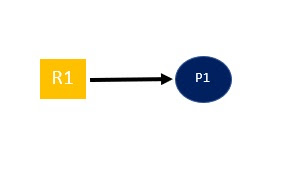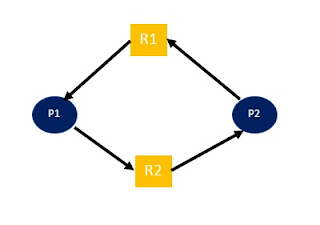Dead lock in Operating System
A dead lock is situation in which two or more process waiting on same event to happen which is never going to be happen then we say those processes are in dead lock.
Dead lock in Operating System
In order to analyze Dead lock in any system we make use of Resource allocation graph.
Resource allocation graph
Resource allocation graph is a graph contain vertices and Edges which represent the Resource,
allocation and Request status for each and every process.
Resource allocation graph = G (V, E) where V is Process or Resources and E is allocation or
Request.
In above resource allocation graph P1 does not leave the resource R1 and cannot stop requesting for R2 similarly P2 does not leave the resource R2 and cannot stop requesting for R1 they are trying to execute thus there is dead lock.
In above case it is seem like dead lock but actually it is not dead lock. Because process P3 and P4 require only one resources which is already allotted thus they execute and release the resources.
Notation used to represent Resource allocation graph.
1. Process will be represented by circle
2. Resources will be represented by Rectangle
5. Allocation is represented as following

One instance of R1 is allocated to P1
Q1 Consider a system with n Process and 6 tape drive and if each process requires two tap drive to complete their execution, then what is maximum value of n which ensure dead lock?
Solution:
The solution is quite easy, let first we check what is given in the question. We have n process and 6 tape drive
each process require two tapes so we first allocate 1 instance of tape drive to each process
P1 – 1
P2 – 1
P3 – 1
P4 – 1
P5 – 1
P6 – 1
as we have only 6 instance of resources, we need one more resources to satisfies the need of each process thus we reduce one process from the above scenario. that’s mean we can able to execute 5 maximum process without any deadlock.
Q2: Consider a system with 3 process each require 2 unit of resources R to complete the execution then what is the minimum number of resources are required to ensure dead lock ?
Solution
This question is little tricky
here we are not going to assign one resources one by one instead of this we take 2 resources at a time like
P1 – 2
P2 – 2
P3 – 2
but this will not ensure deadlock free execution, as there one scenario in which there three process can execute without creating any deadlock like
P1 – 3
P2 – 2
P3 – 1
but as it is not fully ensuring dead lock so 3 is not a right answer
thus right answer is 2 processes, means 2 is the maximum number process which can executed in this scenario without creating deadlock.
Q4: Consider a system with P1, P2, P3 process each require 5, 9, 13 unit of resources R respectively to complete the execution then what is the minimum number of resources are required to ensure dead lock?
Solution:
In question there is need of little bit understanding that first we assign one recourse less then its need like
P1 – 4
P2 – 9
P3 – 12
now system needs one more instance of resource R to complete the need of any one process, than after executing any one processes we get plenty amount of resources to satisfy the need of other process.
Here is list of related post
Dead Lock Prevention in Operating System click here






